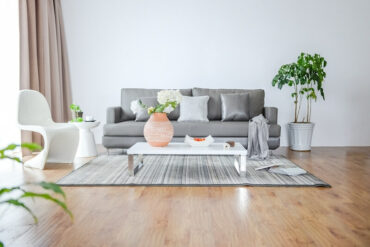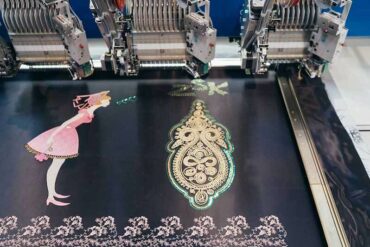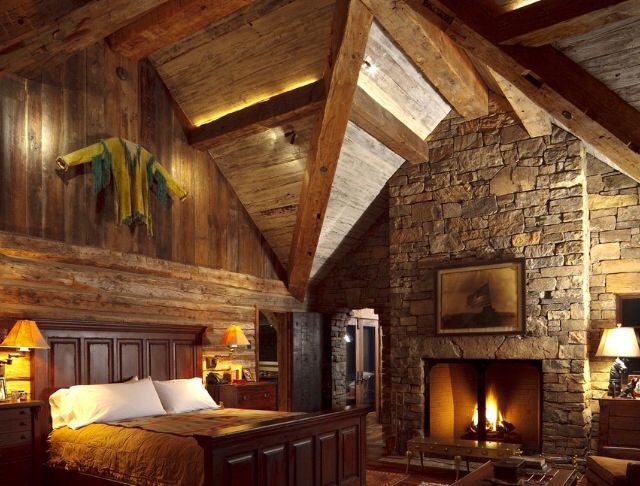
Your home should be a haven for your family and friends, a place of peace and rest where you can gather your thoughts, rejuvenate from your work day, and create memories with your loved ones.
Additionally, your home will always play a special part for you and your children’s memories. Indeed, many of us can probably recall with fondness the aged leather scent from our father’s library, or the aromas of a sun-filled kitchen as our mother baked cookies after school or the crackling fire in our den at the holidays.
There was something magical about that hiding spot in the drawing room where we played with dolls or the window seat where we sat as teenagers dreaming of days to come. House is much more than just the bricks and mortar that make up the structure, but it is the physical expression of who we are.
For the history enthusiast, home decorating can be a beautiful expression of your love for history’s most elegant eras. Read our articles about interior design styles and ideas for each room of your home.
1. French Country Style
French Country has roots in the rolling hillsides of rural France and evokes a cozy, warm and rustic mood. Natural materials are integral parts of the French Country style, reflected in rough plaster walls, natural stone floors and rustic, carved wood furniture.
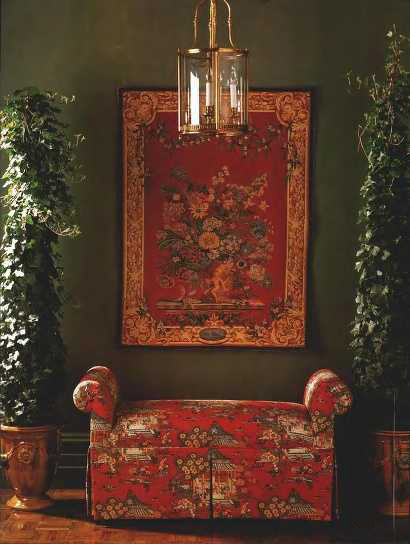
Traditional colors of this style include a combination of earthy tones and bright hues: Cobalt blues, golds, greens, dark reds, black, bright yellow, brown, beige, etc. Decorative accents include rooster collections, tiles on the floor and walls, faded or whitewashed wood, small prints and flowered fabrics and sunflowers in a drip ware pitcher. The style blends the elegant with rustic. Consider a few suggestions to achieve the French Country look.
First, choose the appropriate fabric. Utilize fabric (both solid and printed) that feature intense colors of blue, green, red and yellow. Mix and match with stripes, checks, and plain fabrics in matching or contrasting colors. Yellow and gold are often paired with red, green, or blue, in bright floral and other traditional prints.
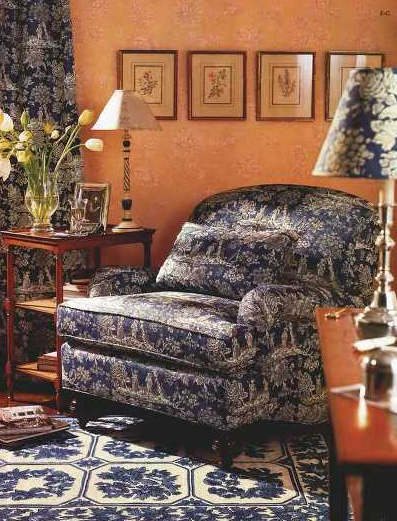
Next, consider decorative accents. Accessorize with baskets, wrought iron, ceramics, crocks, and Chinoiserie pottery, wire baskets, copper pots, old oil paintings, carved wood, tile, and grasses such as rush and sisal. Other accessories can include silk vines, sunflowers, olives and leaves, a bowl of fruit, roosters, etc.
Flowers are essential for a French Country room, whether dried, silk and fresh. Utilize wicker baskets, dented tins and old watering cans to create unique flower boxes that overflow with lush greenery and bright flowers. For dining tables, use bright and colorful dishes. Feel free to mix and match colors and patterns that tie in with your overall color scheme.
Below are some of our favorite French Country Ideas. Get inspired, and click on the following thumbnails to view our favorite French Country rooms.
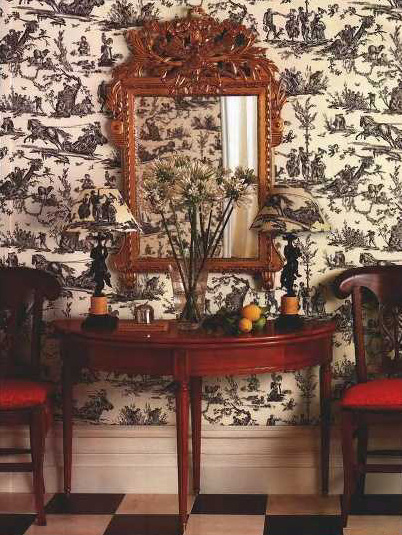
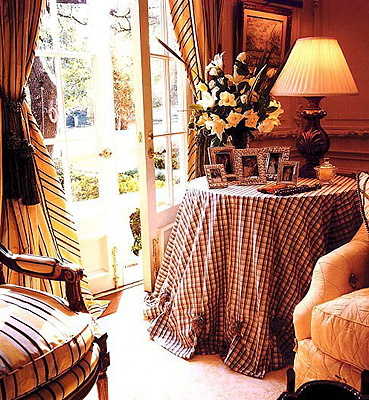
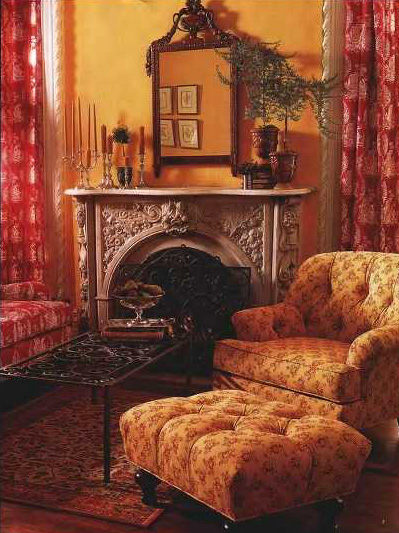
2. Shabby Chic Style
First, as with any decorating style, Shabby Chic requires balance. Place something elegant next to something aged with time, smooth along with textured, dull or worn painted surfaces underneath antique/vintage accessories.
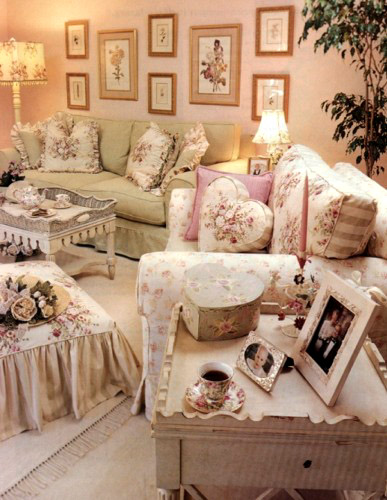
Next, Shabby Chic rooms are well known for the use of slipcovered furniture. The beauty of slipcovers is that they hide wear and tear, mismatched colors and vintage fabrics or patterns. Many Shabby Chic rooms use white slipcovers, but any dulled and muted solid color or pattern can work. Also, no ironing board is required when decorating in the Shabby Chic style, as wrinkled fabrics only add to the charm. Upholstery should not appear pressed, but rather worn.
Additionally, the size of furniture is important in a Shabby Chic room. Comfortable, rumpled, slipcovered, and rounded, chairs in the Shabby Chic style are overstuffed, or large enough to seat two people. Such pieces are welcoming and fit right at home, and a staple of the Shabby Chic room.
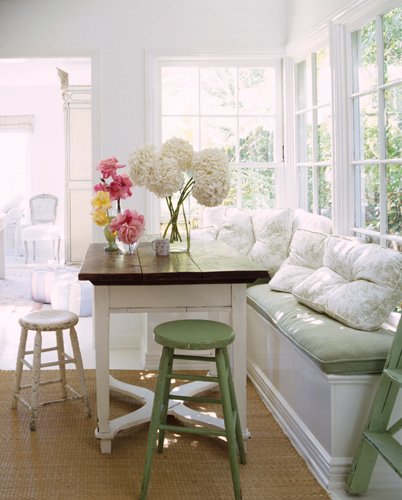
For accent pieces on the wall or tables, use concrete column bases, iron corner brackets, old mantles, and more. These architectural pieces add style and whimsy to your Shabby Chic room!
Finally, keep your Shabby Chic room light by painting your walls and furniture white. Using simple paint techniques, paint old wooden furniture white, with a chipped or cracked finish. Or just use a white garage sale find that already appears worn!
Below are some of our favorite Shabby Chic ideas. Get inspired, and click on the following thumbnails to view our favorite Shabby Chic rooms.
3. Baroque Style
The Baroque style is theatrical and extravagant, with decorative elements intended to startle, electrify and flaunt one’s wealth. The 18th style was popular among the European aristocracy, who were fond of massive and ornate furniture, luxurious textiles, royal and glittery colors, exotic and sparkling accessories, and dramatic floors.
The style was most magnificently showcased at France’s Louis XIV’s palace at Versailles. The decoration and original furnishings at the palace were breathtaking: Its combination of marble and bronze clad walls, wood carving, plaster work, gilt bronzes, mirrors and oil paintings were truly on an unprecedented scale.
The Baroque era saw significant developments in the art of upholstery and elaborate hangings. Items such as valances, curtains, decorative drapery and accessories (feathers, plumes, and carvings) were frequently used. Tapestry was also prevalent, and wall hangings were commissioned for specific rooms.
Baroque was the era that witnessed the start of the paint effect. Whole rooms were treated to simulate tortoiseshell, lapis, and marble. The art of “trompe l’oeil” was applied to wood, making cheap wood resemble expensive or exotic woods.
Below are some of our favorite Baroque ideas. Get inspired, and click on the following thumbnails to view our favorite Baroque rooms.
4. Classical Style
The Classical style reminiscent of ancient Greece, with its use of pillars and columns in both interior and furniture designs. Mahogany wood, with brass inlays, tapestries, marble table tops, and crystal chandeliers will be beautiful accents here.
In reality, the Classical style can be broken up into different schools of interior design. The resurgence in the use of Classical forms in Europe and America started in the late-18th century and gained popularity in the 1820s and 1830s that resulted in the Greek Revival style. Building forms closely mimicked the massive scale and decoration of ancient temples, and decorative arts and furnishings were adorned with or composed of Greco-Roman design elements.
The Colonial Revival refers to a nostalgic return to Early American forms employing motifs from the 18th century, intermingled with Classical designs that had persistently remained popular. The style was birthed by the American Centennial in the mid-1870s and then receded during the 1920s with the dawn of Modernism.
Finally, Neo-Classicism was a design movement popular during the late 18th and early 19th century that grew out of rational reexamination of classical antiquity on Enlightenment ideals. Consider the following suggestions to achieve the Classical look.
First, columns, whether used as an architectural, structural element or as a plant stand, are staples of the Classical style. Purchase small columns from craft or home improvement stores, and spray with metallic paint or stone textured paint to create inexpensive and elegant accent pieces.
Applied ornamentation often lends the Classically inspired interior its grandeur. The style is reflected in Palladian windows, dentil moldings, and Acanthus leaves applied to brackets, corbels, and capitals. However, ornamentation should be added with restraint. If brackets placed every three feet make a grand statement, it need not follow that placing them every 18 inches will look doubly beautiful. Or if your room has eight-foot ceilings, do not specify 12-inch crown moldings with an additional 4-inch dentil frieze.
Every Colonial Revival/Neo-Classicism room should contain a central chandelier often augmented by sconces for additional lighting. Try to find pieces that are substantive and which “fill” the space to be lit without being either overly diminutive or grotesquely large.
Below are some of our favorite Classical ideas. Get inspired, and click on the following thumbnails to view our favorite Classical rooms.
5. Country Victorian Style
The Country Victorian style hearkens back to the decor of the Victorians’ cottages and vacation homes out of the city. The style is characterized by an impressive variety of pastel colors such as mauve, pinks, peaches, pale greens, and blues in floral or fruit patterned fabrics.
Materials such as wood, brass and iron are essential elements in a Country Victorian room. Use a dark oak chest, an old chest with hand grained wood finishes, or plain wall bookcases to display family heirlooms.
Painted wicker, cottage flowers, and herbs, lightly covered windows draped with gauzy fabrics and laces add to the Country Victorian look. Place handmade rugs on the floors, and drape blankets or embroidered rugs over armchairs. Accessorize with dried flower arrangements.
Below are some of our favorite Country Victorian ideas. Get inspired, and click on the following thumbnails to view our favorite Country Victorian rooms.
Historical Bedroom Decorations
Bedrooms are traditionally the most personal of rooms in one’s house, reflecting the unique likes and personalities of their residents.
For history enthusiasts, a bedroom offers an excellent opportunity to share a love for elegant style from the grandest eras of the past. Even if you don’t own authentic period furniture in your bedroom, you can use what you do have and add historical touches.
First, look at your existing pieces of furniture and make sure they are arranged to allow for the best use of space. When you walk into your bedroom, does space look confined or open? Your goal should be to see the main pieces of furniture from the entrance.
Also, consider placing the furniture in a historically-accurate design. In 19th century homes, for example, a chaise or bench was often placed at the foot of the bed.
Alternatively, in earlier times, beds were often raised high, and a wooden step stool placed at the side of the bed for easy access.
Second, decide on a color theme for your room. Whether you choose light, muted, dark or rich colors, your room should be focused around one main color theme, and one or two accent colors.
For example, if you love mauve, some of the key elements in your room (e.g. rug, wallpaper, bed linens) should have mauve in them. Accent the mauve theme with one or two main complementary colors such as ivory and sage. You don’t need to limit yourself to using only furniture and accessories with only these three colors, but keep the main pieces consistent with your color theme.
The goal is that when you survey your room, there will not be any one item that stands out visually because its color is jarring against the rest of the theme. Peaceful bedrooms reflect a harmonious blend of visual elements.
We also suggest keeping your “metals” in any given room to one color. If your dresser has brass or gold finished knobs and handles, then keep your photo frames and other accent pieces to gold. Using silver and gold together tends to create an unbalanced look. Similarly, choose a dark wood for your furniture, and keep the pine and oak furniture out of the bedroom (as light woods evoke a modern feel).
Don’t be afraid to update what you have or refinish a garage sale find. Decorating your home in historical style need not require a lot of money. Refinish furniture using a weathered stain to create an aged look. You can also dye white fabrics in a “tea dye” to create the look of antique linens. Reupholster a chair with toile or another historically patterned fabric. Give your comforter a new look by covering it with a duvet, or toss a reproduction quilt over your existing linens.
If you are inclined to sew, consider adding reproduction trim, laces, and ribbon to adorn your curtains, sheets and blankets. Stitch tassels and trim on your existing pillows and shams for an elegant, Baroque-inspired look. A four-poster or canopy bed is a small investment that can add a touch of historical elegance to any bedroom.
If your budget is tight, consider finding a canopy bed at a rummage sale, refinish the wood yourself. Then make your canopy by purchasing vintage style fabrics or laces to drape over the top. Be creative!
Finally, if your bedroom allows for a small sitting area, remember to keep the color theme of your furniture, pillows, and accessories consistent with your bed. Embellish your bedroom with signature historical elements such as lace curtains, tassels, glass hurricane lamps, chandeliers, sconces, reproduction paintings, and tapestry pillows.
Consider adding a few “fun” items to make the room appear authentic, such as a black and white photograph of your grandparents on their wedding day, placed in a vintage frame. Or display an “antiqued” picture of your family (easily obtained at most amusement parks and other recreational sites).
Finally, a word of advice. Make sure you live with what you love. Don’t just choose accent items merely because they “go with the rest of the room.” Make sure you like the items that adorn your room, and we guarantee you will enjoy waking up to them each day.
Nursery Decoration In a Vintage Style
Within the walls of your nursery, your sweet little one learns about his new world. A nursery provides a warm, calming space for infants to be nurtured, mothers to find rest, and families to gather to enjoy their young ones.
In the first few months of your child’s life, your nursery will likely be a favorite, familiar space. So take care in creating a unique, loving room for your baby. If possible, begin decorating your nursery well before your baby’s due date.
The last few weeks of pregnancy tend to be a very busy time, and although expecting mothers often feel a nesting instinct to make preparations, they will need the rest for the delivery and newborn care, soon to come. You will save yourself a lot of troubles if your nursery is finished at least one month before your due date so that a special, inviting space is ready for your new addition (even if your baby arrives earlier than expected).
Because children in their first few years of life grow and change so quickly, it is also important for your nursery to be designed and decorated with the future in mind. A nursery for your infant can soon become a playroom for a toddler, or bedroom for your young child. In order not to purchase too many items which will only be used for a short time, look for pieces which have multiple purposes.
A dresser with a changing table on top can be used for many years to store your child’s clothing and accessories. Long after the changing pad is removed, you can use the tabletop to display mementos, photo frames, and figurines. You can also convert an old piece of furniture into a changing table.
A sturdy, old-fashioned secretary desk, dresser, or buffet can function as a changing table with the addition of a comfortable padded bumper top and Velcro straps, as well as provide storage for wipes, ointments, and other necessities. Some baby furniture stores offer armoires that have a changing table which slides out (like a drawer).
Rather than purchasing a bassinet which can only be used for a few months, consider using a crib from the beginning, or a convertible “play yard” which usually can be used as a bed, changing the station and later, a playpen.
Also, because the nurseries tend to be smaller rooms, try not to overdo your baby’s surroundings. Determine which pieces of furniture are necessary for you and your baby. A crib, changing table, and glider are nursery staples, but parents can also add other pieces to the unique needs of each family.
For example, a playful area rug or child-sized couch might be convenient if there are older siblings who may sit in on afternoon storytime sessions. Or, if both parents will be involved in feeding and caring for a new baby, an armchair or upholstered bench may provide additional seating next to a mother’s rocker. If space allows for it, consider a piece of furniture for an adult to curl up for the evening.
Parents who are stationed in the nursery for a vigil to care for a sick child or need to get up often for a fussy baby in the first few months may appreciate a small daybed, futon or sleeper sofa, or, at least, a slipcovered chaise or extra-wide easy chair. To save space, consider wall-mounted shelves or Shaker-style peg hooks, that can grow with your child and display all the special keepsakes from his or her baby and childhood years. Plenty of shelf space leaves floor space available for what it was intended: play!
Once you have determined the necessary items of furniture, decide on a theme. Some parents choose a theme based on the gender of the child while others prefer to keep it neutral. The history enthusiast can create a vintage style nursery using a variety of themes.
For example, a Victorian style nursery will include dark woods, classic prints, antiques, and heirlooms. Consider purchasing a few antique reproduction toys, such as wooden planes or trains, or Victorian teddy bears or dolls, as special touches.
Nurseries for little girls can include a mix of lace fabrics, toile upholsteries, cradles with intricate details, and hand-painted furnishings. A whimsical, hand-painted pendulum clock can provide a sweet addition, and is perfect for mothers during late-night feedings and babies (who love the motion of the pendulum).
Parents fond of eclectic, casual decorating may want to adopt a Shabby Chic style for a nursery. Find a crib painted in a distressed white finish, and then choose a mix of light, cotton fabrics. A cozy, upholstered glider and unique vintage finds can complete the look. Keep the nursery bright and white; it will make a relaxing space and cheerful palette for your child’s imagination.
Finally, fairy tale and castle themes are also very popular and allow for royal touches inspired by the medieval and Renaissance times. There are plenty of ornate, regal cribs, armoires and toy chests that can be personalized for your little prince or princess.
Every nursery should include a touch of whimsy. If your budget allows for it, consider splurging a little on one special item that can serve as your inspiration piece for the room. Companies such as PoshTots, Babystyle, and Cradle n’ Crib offer unique and beautiful baby furniture, bedding and accessories.
Our favorites include a dresser that is shaped like a giant carrot (an excellent addition to a nursery inspired by an enchanted forest, bunnies or Beatrix Potter characters), upholstered child-sized armchairs, and an over-the-top magical pumpkin coach (an unforgettable touch for a true princess)!
Christmas Dining Rooms in Victorian Style
The holiday season can be a time filled with festive gatherings of families and friends. For example, Victorians began the custom of exchanging Christmas cards with friends and invented Christmas crackers filled with small gifts.
Moreover, the economy of the times allowed for the grand celebration of the holiday like never before. The wealth generated by Victorian age industries allowed middle-class families in England and Wales, in particular, to take time off from work and celebrate over two days, Christmas Day and Boxing Day. Families suddenly found the time and reason for decorating their homes and enjoying lavish dinners!
This season, don’t be afraid to mix and match styles. For your dining table, try layering on different fabrics–a richly trimmed brocade tablecloth, topped with a sparkling runner or even a square quilt, and finished off with colorful doilies, handkerchiefs, and ribbons for panache. Spruce up your table with a combination of plates (that need not be the same pattern). Use gold or silver charger plates to create a formal look, and then mix and match a variety of fancy plates, layered atop one another.
Or, for a more subdued and clean look, use tone-on-tone whites this season, and adorn your table with wintry, frosted poinsettias, berries, and snowball candles. Don’t forget to lay a few Victorian Christmas “firecrackers” on your table for fun after the meal!
And as a final note, no Victorian home is complete during the holidays without a Christmas tree. The symbol of the Christmas tree can, in fact, be traced back to the 7th century. According to tradition, a monk from Crediton, Devonshire, went to Germany to teach the Word of God to the people. He used the triangular shape of the local-grown fir tree to describe the Trinity: the Father, Son, and Holy Spirit.
Early Christians continued the use of the tree as a symbol of the Christian faith. By the 12th century, fir trees were hung from ceilings at Christmastime in Central Europe as a symbol of faith. During the 16th century, Protestant reformer Martin Luther reportedly decorated a small tree with candles to tell the story of Christ’s birth and how the stars twinkled through the night.
Before long, trees were decorated in houses all across Germany for Christmas time. Real silver was produced in strands of tinsel and hung on the tree along with candles and other small ornaments. However, it was not until the Victorian era when the Christmas tree truly became a holiday staple, after Queen Victoria and her German husband Albert made Christmas trees all the rage. Young Victorian ladies quilled snowflakes and stars, made paper baskets, and fashioned bead decorations for their trees. Germany also imported lovely angels to top the tree.
By the early twentieth century, ornaments were manufactured and sold to the masses. Garlands, glass tree ornaments, glitter and small toys adorned trees that have become more elaborate over the years. If your dining room allows space, consider placing a tree in the corner to add some holiday warmth. Even a small tree will do! Your guests will never forget the experience of a holiday meal by the light of a real Christmas tree.



